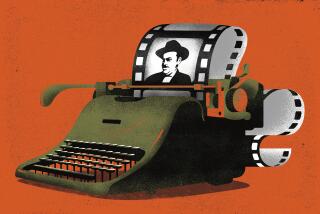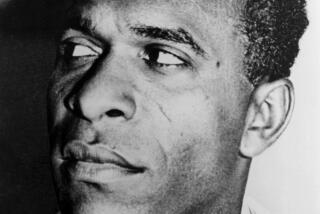The prosecution rests
VINCENT BUGLIOSI is an American master of common sense, a punishing advocate and a curmudgeonly refreshing voice of reason.
His targets have been the loopy and the deranged, the deceitful and the violent. And so, a career launched with the prosecution of Charles Manson and honed with a book parsing the defense of O.J. Simpson has, with seeming inevitability, come around to 20th century America’s great repository of poor reasoning: the assassination of President Kennedy on Nov. 22, 1963.
After reading what may be Bugliosi’s crowning work (more than 1,600 pages, not to mention an additional 1,100 pages of notes on an accompanying CD), one thinks: At last, someone has done it, put all the pieces together. “Reclaiming History: The Assassination of President John F. Kennedy” is important not just because it’s correct, though it is. It’s significant not just because it is comprehensive -- surely, no one will deny that. It is essential, first and foremost, because it is conclusive. From this point forward, no reasonable person can argue that Lee Harvey Oswald was innocent; no sane person can take seriously assertions that Kennedy was killed by the CIA, Fidel Castro, the Mob, the Soviets, the Vietnamese, Texas oilmen or his vice president, Lyndon B. Johnson -- all of whom exist as suspects in the vacuous world of conspiracy theorists.
Each may be guilty of crimes, but none had anything to do with Kennedy’s assassination. “Reclaiming History” may finally move those accusations beyond civilized debate.
Not everyone who dares to heft Bugliosi’s tome will be happy with it. He is not an ingratiating writer; his tone, as always, is prosecutorial. He writes aggressively and sarcastically. There’s not a lot of finesse on display. He’s a slugger, not a stylist. Think Ruth, not Clemente.
Bugliosi, whose previous books include “The Betrayal of America: How the Supreme Court Undermined the Constitution and Chose Our President” (2001) and “No Island of Sanity: Paula Jones v. Bill Clinton” (1998), begins by re-creating the events of the assassination, describing the investigations into that terrible day and examining the evidence collected by the various police agencies, the FBI, the commission led by Supreme Court Chief Justice Earl Warren and others. Bugliosi is a keen analyst of that material; his dissection of the medical evidence is particularly telling. He establishes that Oswald fired three shots from the window of the Texas School Book Depository. One missed; one hit Kennedy in the upper back, then passed through his body and pierced then-Texas Gov. John B. Connally; the third struck Kennedy in the back of the head, killing him.
No shots -- not hits or misses -- were fired from the grassy knoll or any other place around Dallas’ Dealey Plaza. A single bullet wounded both Kennedy and Connally, traveling in a nearly straight line, only to be deflected when it hit the governor’s rib. Those findings, echoed again and again by independent examinations in the decades since the Warren Commission made them, lay the groundwork for the book’s emphatic conclusions: Oswald killed Kennedy, and he acted alone.
Bugliosi’s presentation of this material is so deft, so strong, that there is little need for him to turn his skills against the conspiracy theorists who argue otherwise. But he does, determined to give each theory the honest, probing review to which most have never been exposed.
It is a sight to behold. When Bugliosi lays into a bad argument, he attacks without mercy. He hammers again and again, challenging flawed logic with heavy fists. Of a historian’s much-repeated belief in an impostor Oswald, Bugliosi writes. “Apparently Walt Brown’s good mind was taking a rest when he wrote those words.” Of the theory that Robert F. Kennedy was involved in a cover-up of his brother’s assassination, going so far as to meddle in the disposal of the president’s brain, Bugliosi laments: “Is there any end to the silliness?”
That’s barely a sampling. Given that there are more than 1,000 conspiracy books on this subject, Bugliosi has his work cut out, but he slogs away. The allegation that the memorable photograph of Oswald holding the rifle that fired the fatal shots was a forgery -- a ludicrous proposition undermined by photographic evidence as well as testimony by Oswald’s wife, Marina, that she took the picture herself -- is brusquely dismissed with evidence of its absurdity. Concluding that section, Bugliosi writes: “I could continue this safari into delirium, but enough.”
When he examines documents purporting to supply evidence of CIA involvement in the assassination, Bugliosi snaps again. “Can you imagine that, folks?” he writes. “The CIA has confessed to Kennedy’s murder! And in writing!”
The sheer lunacy of many of the theories, along with the intellectually dishonest way in which they have been argued, should long ago have doomed them to marginalia. They have persisted, however, and continue to command much public support. That’s true despite the fact that none has ever offered a counter-theory backed by real evidence. There are only the findings of the Warren Commission and critics of that commission, none of whom have overturned those findings.
Indeed, all that conspiracy theorists have shown is that there were plenty of people who might have wanted Kennedy dead. That’s a far cry from proving they killed him. Or, as Bugliosi puts it: “The biggest mistake, by far, that well-intentioned lay people make in concluding there was a conspiracy in the Kennedy assassination, and the biggest argument, by far, that conspiracy theorists use in their books to support their position of a conspiracy, is to maintain that such and such a group ‘had a motive’ to kill Kennedy and, therefore, must have done it.”
And what of that idea? “You know,” Bugliosi writes mockingly, “if the president of our country is doing something that a particular group (e.g., Wall Street or unions or environmentalists) doesn’t like, the group simply kills him. That’s what we routinely do in America, right?”
Those who come to Bugliosi’s book with sympathy for conspiracy theories may wince at the punishment he inflicts across so many pages. He suffers no fools, and Kennedy’s assassination has produced more than its share of foolish speculators; he will make some enemies with this work. It seems fair to say that he’s unlikely to care.
Others will quibble with his style -- he has an unfortunate habit of shifting back and forth between present and past tense -- but the spine of this work is research and argument.
In some passages, Bugliosi reveals subtlety and empathy as a writer. Recounting the sad aftermath of the world’s farewell to Kennedy, the author describes the president’s widow and his brother kneeling at the grave of “our friend” just before midnight. “Rising, Jackie places the spray of lilies on the grave. Together, they turn and walk down into darkness and into lives that would never be the same.”
Bugliosi’s book isn’t for everyone. It is, by his admission, one of “abnormal length.” Its organization -- a scintillating, minute-by-minute account of the events surrounding the assassination that segues into long chapters examining aspects of the case in fine detail -- results in a certain amount of repetition.
But no serious scholar of the president’s assassination will ever write again on the subject without citing Bugliosi. And there are more works to come -- most promising, a long-awaited look at the Warren Commission from author Max Holland (“The Kennedy Assassination Tapes”).
No doubt there also will be more works of confusion and idiocy. Happily, however, from this point forward, all contributors to the field must build on “Reclaiming History.”
With this work, Bugliosi has definitively explained the murder that recalibrated modern America. It is a book for the ages.
*
More to Read
Sign up for our Book Club newsletter
Get the latest news, events and more from the Los Angeles Times Book Club, and help us get L.A. reading and talking.
You may occasionally receive promotional content from the Los Angeles Times.







